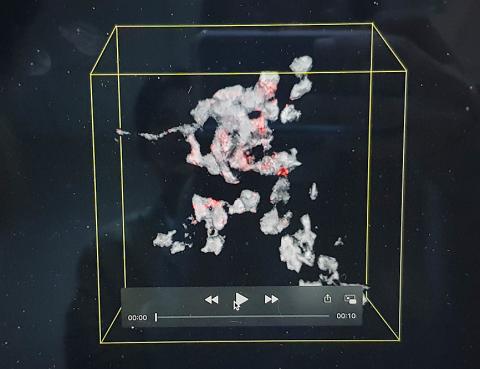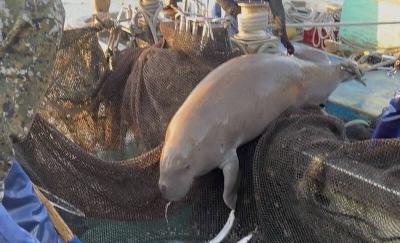A team of researchers yesterday touted novel imaging systems for observing the dynamics of single neurons in living fruit flies’ brains, hoping to apply the tools to understand human brains.
A fruit fly brain contains more than 100,000 cells and measures less than 1mm deep and a rat brain contains about 100 million cells and measures 1cm deep, while a human brain houses up to 100 billion cells and measures 10cm deep, National Taiwan University (NTU) physics professor Chu Shi-wei (朱士維) told a news conference at the Ministry of Science and Technology in Taipei.
To explore the profound mystery of the human brain, the team started with fruit fly (Drosophila) brains, Chu said.

Photo: Chien Hui-ju, Taipei Times, courtesy of Chu Shi-wei
While magnetic resonance imaging and positron emission tomography can take whole human brain images, their resolutions are not enough to probe single neuron behaviors, he said.
Optical microscopes, though limited in penetration depth, are more helpful in observing whole-brain neuronal connections in a small animal like fruit flies, he said.
Aided by engineers and biologists from NTU, National Tsing Hua University and National Chiao Tung University, Chu said his team developed a high-speed volumetric imaging system that might be the first in the world to capture the millisecond-scale 3D neuronal firing dynamics in a living fruit fly brain.
Combining that with a home-built optogenic stimulation system, the team was able to capture the in vivo 3D functional connection and coding of the fly’s visual circuits, he said.
To identify the structural connection of the fly’s nerve fibers, the team also built a system called Confocal Localization Deep-imaging with Optical Clearing, with 20-nanometer spatial resolution, which is 10 times better than that of conventional optical microscopes, he said.
The team also produced a long-wavelength three-photon microscopy enabling whole-brain imaging in a living fruit fly, after they found the penetration depth of conventional two-photon microscopy in fruit fly brain was much less than that in a mouse brain due to their different brain structures, he said.
Chu’s team published four research papers on the achievements in the journals Optics Letters, iScience and Biomedical Optics Express last year.
Chu was also invited by the journal Light: Science and Applications to write an introductory article on optical microscopy, which was published in December last year.
The techniques might improve understanding about neurological diseases, such as Alzheimer’s, in fruit flies and in human brains, Chu added.
While Academia Sinica physicist Hwu Yeu-kuang (胡宇光) and other Asian scientists in January established the Synchrotron for Neuroscience — An Asia Pacific Strategic Enterprise (SYNAPSE) alliance, vowing to produce the world’s first human brain map by 2023, Chu’s team has taken a different approach.
While the alliance aims to use intensified X-ray methods to capture the “structures” of dead brains, the team’s methods purport to observe the brain “functions” in “living” animals by studying connection dynamics, National Tsing Hua University assistant professor of biomedical engineering Chu Li-an (朱麗安) said.
However, the team might need to study the brains of other mammals first before their techniques can be applied to humans, she added.

‘DENIAL DEFENSE’: The US would increase its military presence with uncrewed ships, and submarines, while boosting defense in the Indo-Pacific, a Pete Hegseth memo said The US is reorienting its military strategy to focus primarily on deterring a potential Chinese invasion of Taiwan, a memo signed by US Secretary of Defense Pete Hegseth showed. The memo also called on Taiwan to increase its defense spending. The document, known as the “Interim National Defense Strategic Guidance,” was distributed this month and detailed the national defense plans of US President Donald Trump’s administration, an article in the Washington Post said on Saturday. It outlines how the US can prepare for a potential war with China and defend itself from threats in the “near abroad,” including Greenland and the Panama

A wild live dugong was found in Taiwan for the first time in 88 years, after it was accidentally caught by a fisher’s net on Tuesday in Yilan County’s Fenniaolin (粉鳥林). This is the first sighting of the species in Taiwan since 1937, having already been considered “extinct” in the country and considered as “vulnerable” by the International Union for Conservation of Nature. A fisher surnamed Chen (陳) went to Fenniaolin to collect the fish in his netting, but instead caught a 3m long, 500kg dugong. The fisher released the animal back into the wild, not realizing it was an endangered species at

The High Prosecutors’ Office yesterday withdrew an appeal against the acquittal of a former bank manager 22 years after his death, marking Taiwan’s first instance of prosecutors rendering posthumous justice to a wrongfully convicted defendant. Chu Ching-en (諸慶恩) — formerly a manager at the Taipei branch of BNP Paribas — was in 1999 accused by Weng Mao-chung (翁茂鍾), then-president of Chia Her Industrial Co, of forging a request for a fixed deposit of US$10 million by I-Hwa Industrial Co, a subsidiary of Chia Her, which was used as collateral. Chu was ruled not guilty in the first trial, but was found guilty

DEADLOCK: As the commission is unable to forum a quorum to review license renewal applications, the channel operators are not at fault and can air past their license date The National Communications Commission (NCC) yesterday said that the Public Television Service (PTS) and 36 other television and radio broadcasters could continue airing, despite the commission’s inability to meet a quorum to review their license renewal applications. The licenses of PTS and the other channels are set to expire between this month and June. The National Communications Commission Organization Act (國家通訊傳播委員會組織法) stipulates that the commission must meet the mandated quorum of four to hold a valid meeting. The seven-member commission currently has only three commissioners. “We have informed the channel operators of the progress we have made in reviewing their license renewal applications, and